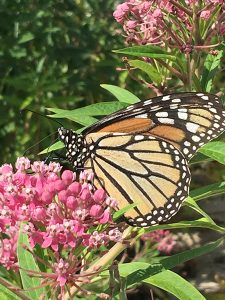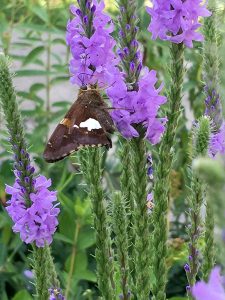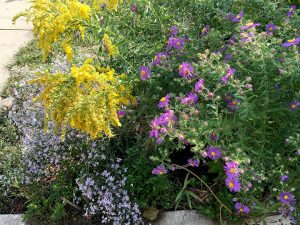Life in the Garden with Native Plants
BY MARTI MACARTHUR, WORC VICE PRESIDENT
Published in the Sept-Oct edition of Eastown Access
 How is your garden growing this year? Are you seeing a variety of bees and butterflies coming to your flowers and lingering as they seek the nectar and pollen they need for their survival? Are you seeing birds in your shrubs and gardens, looking for bugs, caterpillars, and seeds from the flowers? Perhaps you haven’t noticed or maybe there weren’t very many visitors. If not, the creatures are telling you that your plants are not a source of food for them and there is not a reason for them to linger in your garden.
How is your garden growing this year? Are you seeing a variety of bees and butterflies coming to your flowers and lingering as they seek the nectar and pollen they need for their survival? Are you seeing birds in your shrubs and gardens, looking for bugs, caterpillars, and seeds from the flowers? Perhaps you haven’t noticed or maybe there weren’t very many visitors. If not, the creatures are telling you that your plants are not a source of food for them and there is not a reason for them to linger in your garden.
The pollinators and insects are seeking the recognized food sources that they have depended on for thousands of years and with which they have evolved. The plants they seek are what we are currently calling “native plants.” Native plants provide nectar, pollen and food from their leaves for nourishment and reproductive needs.
Many of the plants we see as a part of our formal landscape are plants that were brought here from other countries which are called “non-native, alien, or exotic.” We also have what is referred to as “cultivars” and “nativars.” These plants may look like the native plant, but through vegetative reproduction a characteristic of the plant such as color, size, shape of the blossom, etc., has been altered which can affect pollen and nectar quantities or access for the pollinators. Knowing the exact Latin name for the native plant will help ensure that you are getting a native plant which participates in natural reproduction patterns that maintain genetic diversity of the species.
 Perhaps you have been thinking that you want to make your garden more life sustaining and you would like to add native plants into the mix of plants that you have. How does one start? In looking at multiple resources there are some general guidelines I would like to share with you to help you have success with introducing native plants into your garden followed by a short list of some great plants that will enhance the biodiversity of your garden.
Perhaps you have been thinking that you want to make your garden more life sustaining and you would like to add native plants into the mix of plants that you have. How does one start? In looking at multiple resources there are some general guidelines I would like to share with you to help you have success with introducing native plants into your garden followed by a short list of some great plants that will enhance the biodiversity of your garden.
Begin by paying attention to the amount of sunlight that the area you would like to plant receives. Is it sunny most of the day, partially sunny with some shade, or is it quite shady with little sunlight throughout the day?
Next, what is the soil like it that spot? Is it quite dry or does it retain moisture even though it wasn’t watered recently? It is often recommended that getting an analysis of your soil can be helpful if you are not sure about the soil in your garden.
Next, remove all existing vegetation from the area you wish to plant. This may involve smothering with plastic and cardboard for a season, or if you aren’t interested in waiting, pulling the existing plants, removing sod with a spade or in cases of a large area, spraying the area with an organic herbicide or a low toxicity glyphosate herbicide. Be sure to follow all label directions. You may have to repeat this procedure if the plants you are trying to get rid of, English Ivy, Myrtle or Vinca, for example, return after the initial removal.
Once you have your space ready, seek out native plant sources for plants. Be sure to ask at your local nursery but be sure to specify that you are seeking the nativevariety. If you use the Latin name that will help insure that you are getting the correct plant. There are sources for Native Plants if you look on line for “native plants in Michigan” and the website for Wild Ones River City, RiverCityWildOnes.orghas lists of local growers as well as events where native plants can be purchased.
Once you have found the plants you were seeking, bring them home and plant them. Native plants need watering and keeping the weeds away. The first year the growth will mostly be in the roots and so you may not see too much in terms of flowers. It often works best to plant in groups so that the bees and butterflies find them easier and do not have to fly so far to get the food they seek from the plant.
Once the plants are established, they will be able to go longer without watering, but still will need your care at times for pruning, thinning and weeding. Once they are established prepare yourself for an amazing level of activity from the pollinators as they discover your garden. You will see for yourself that they know your garden is a place where nourishment awaits them.
If you would like some ideas as to some plants that are great in the garden, here are a few suggestions:
Sun:
• Swamp Milkweed (Asclepias Incarnata),pink blossom, Monarchs love it.
• Blue Lobelia (Lobelia siphilitica), Blue flower loved by bees and butterflies.
• Purple Cone Flower (Echinacea purpurea).
Shade:
• Columbine (Aquilegia Canadensis),Red and yellow, loved by hummingbirds and bees.
• Wild Ginger (Asarum canadense),ground cover. Green heart shaped leaves with flower tucked under the leaves.
• Spikenard (Aralia racemosa).White flower, 3–6 ft., berries.
“Chances are, you have never thought of your garden—indeed, of all the space on your land—as a wildlife preserve that represents the last chance we have for sustaining plants and animals that were once common throughout the United States. That is exactly the role of our suburban landscapes are now playing, and will play even more critically in the near future. If this is news to you, it is not your fault.”
—Dr. Douglas Tallamy, University of Delaware, Department of Entomology and Wildlife Ecology and author of the book, Bringing Nature Home.
When thinking about your choices in plants for the garden, please consider adding some native plants. Mother Nature will reveal to you how important your garden is to the creatures with which we share this space.

